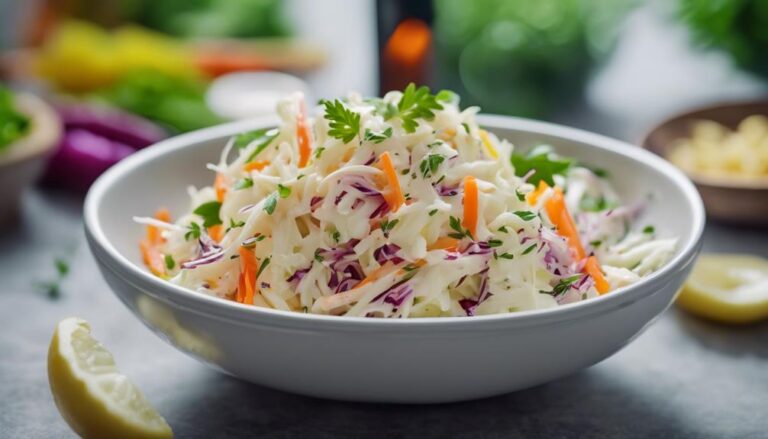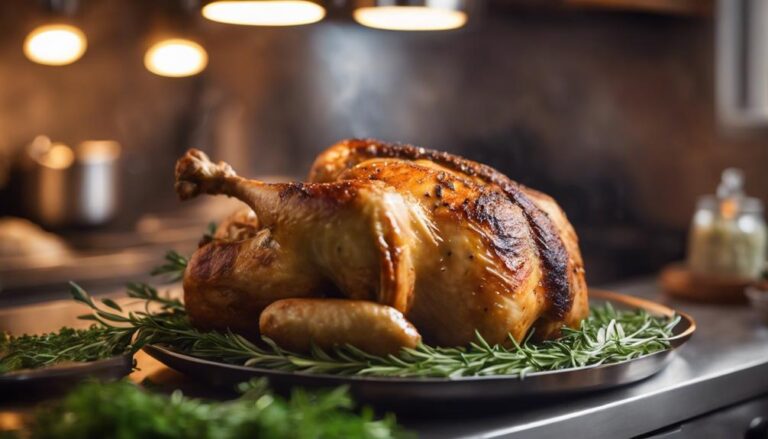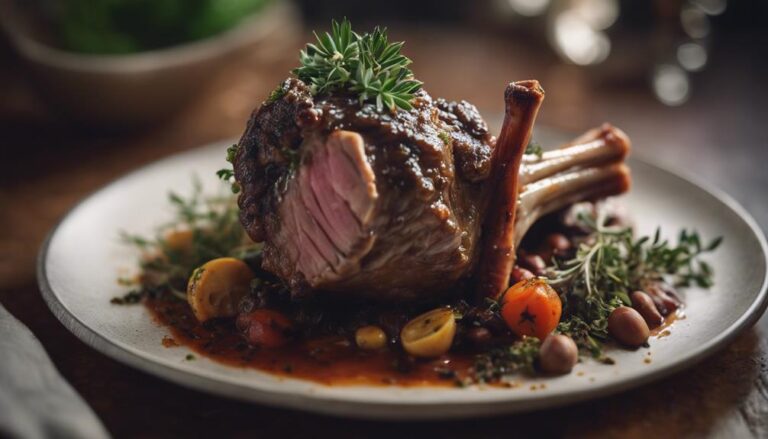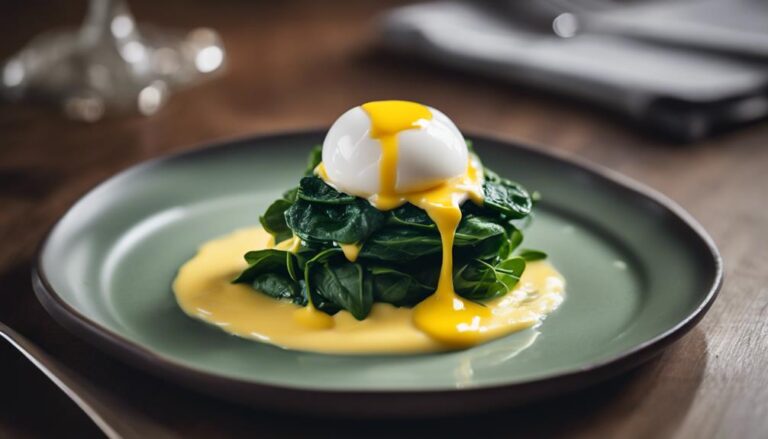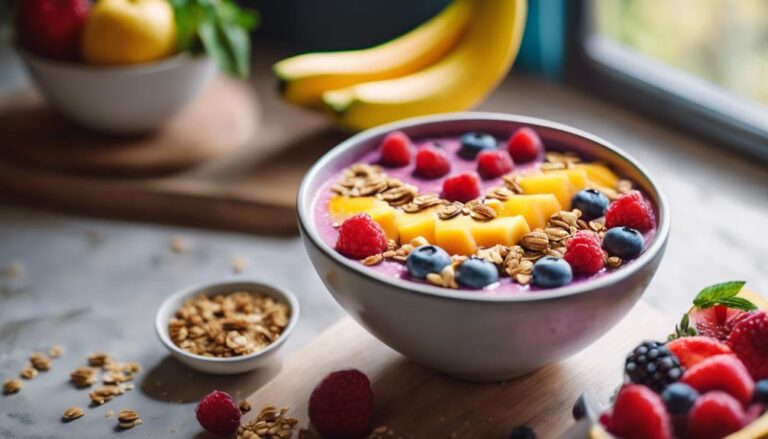Revelation’s Rich Sous Vide Beef Stew
Experience the rich flavors of Revelation's sous vide beef stew, where tender chuck roast and savory vegetables meld into a culinary delight. Enjoy succulent results achieved through precise temperature control and enhanced flavor infusion techniques. Elevate your dining experience with innovative variations like red wine reduction and Guinness stout infusion. Ignite your creativity by personalizing the stew to suit your palate with a variety of herbs and vegetables. Intrigued to uncover more about the origin of sous vide and trending beef stew variations that will take your culinary skills to the next level?
What You Will Learn Here
- Utilize vacuum-sealed bags for flavor infusion.
- Rest meat for optimal succulence and texture.
- Finish with searing for a caramelized crust.
- Experiment with various herbs and vegetables.
- Explore innovative variations like red wine reduction.
Origin of Sous Vide

Sous Vide has a fascinating history that traces back to French origins.
This cooking technique has evolved over time, with modern technology making it more accessible to home cooks.
Understanding the roots of sous vide provides insight into its significance in contemporary culinary practices.
Sous Vide History
With origins dating back to the 18th century, the cooking technique known as sous vide has evolved over time to become a popular method among chefs and home cooks alike. The evolutionary advancements in sous vide have revolutionized the culinary application of this method, allowing for precise control over cooking temperatures and resulting in perfectly cooked dishes.
Originally developed in France, sous vide, meaning 'under vacuum,' initially focused on food preservation before evolving into a method that emphasized flavor and texture enhancement. Chefs began to recognize the benefits of cooking food in vacuum-sealed bags immersed in temperature-controlled water baths, leading to the widespread adoption of sous vide in professional kitchens and households worldwide.
This rich history showcases how sous vide has seamlessly integrated into modern cooking practices.
Cooking Technique Evolution
The evolution of cooking techniques, particularly the origin of sous vide, traces back to the 18th century and has since undergone significant advancements in precision and control over cooking processes.
Throughout history, culinary innovation has driven the development of evolutionary cooking methods, leading to the refinement of sous vide as it stands today. This technique revolutionized the culinary world by introducing a method that prioritizes retaining flavors and nutrients through precise temperature control and prolonged cooking times.
The journey of sous vide showcases how chefs and food enthusiasts have continuously endeavored to perfect their craft, pushing the boundaries of traditional cooking methods. This dedication to excellence has paved the way for a new era of cooking, where precision and flavor intertwine to create extraordinary dining experiences.
Modern Sous Vide Technology
Innovations in culinary technology have transformed traditional cooking methods, leading to the emergence of modern sous vide techniques. Modern sous vide technology allows for precise temperature control, ensuring that your dishes are cooked to perfection every time.
With this method, you can serve your guests with confidence, knowing that each bite will be tender and flavorful. The precision cooking offered by sous vide technology eliminates the guesswork, guaranteeing consistent results.
Beef Chuck Roast Ingredients

For flavorful beef chuck roast in your sous vide stew, gather these key ingredients:
- Beef Chuck Roast: Select a well-marbled chuck roast for rich flavor and tender texture.
- Root Vegetables: Carrots, onions, and celery add depth and earthiness to your stew.
- Beef Broth: A hearty beef broth will enhance the savory profile of your stew.
When preparing your beef chuck roast for sous vide cooking, it's crucial to choose a quality cut of meat with enough marbling to guarantee a succulent and flavorsome result. Root vegetables like carrots, onions, and celery not only complement the beef's richness but also contribute to the overall aroma and taste of the stew. To top it off, using a robust beef broth will elevate the umami notes in your dish, creating a well-rounded and satisfying flavor profile.
Trending Beef Stew Variations
You'll want to explore the latest trends in beef stew variations.
Like the savory red wine reduction that adds depth.
The hearty Guinness stout infusion for a robust flavor.
And the vegetable medley garnish that brings a pop of freshness.
Savory Red Wine Reduction
To elevate the flavor profile of your beef stew, consider incorporating a rich and savory red wine reduction. Red wine reductions add depth and complexity to your stew, enhancing the overall dining experience.
Here are a few tips to help you master this flavorful addition:
- Choose the Right Wine: Opt for a full-bodied red wine like Cabernet Sauvignon or Merlot for a robust flavor that complements the hearty nature of the stew.
- Reduce to Intensify Flavor: Simmer the wine slowly to concentrate its flavors, creating a velvety sauce that enriches every bite.
- Balance Sweetness and Acidity: Adjust the sweetness and acidity levels of the reduction with a touch of sugar or vinegar to achieve a harmonious taste that pairs perfectly with the beef.
Hearty Guinness Stout Infusion
Consider elevating your beef stew with a hearty Guinness Stout infusion, adding a robust depth of flavor that complements the rich sous vide cooking method. The combination of the beer pairing and slow cooking creates a rich broth with a unique flavor profile that will impress your guests.
Here are a few tips to make the most of this infusion:
- Use a good quality Guinness Stout for a robust flavor.
- Slowly add the stout during the cooking process to allow the flavors to meld.
- Adjust the amount of stout based on your preference for a stronger or milder taste.
Vegetable Medley Garnish
Enhance your rich sous vide beef stew with a vibrant vegetable medley garnish to add a fresh and colorful twist to this classic dish. By incorporating a flavorful broth and a colorful presentation, you can elevate the overall dining experience for your guests.
Consider the following to create a visually appealing and tasty vegetable medley garnish:
- Fresh Herb Sprinkle: Chop a mixture of fresh herbs like parsley, thyme, and chives to sprinkle over the stew just before serving.
- Colorful Bell Pepper Strips: Add a pop of color by sautéing red, yellow, and green bell pepper strips until slightly caramelized.
- Butter-Tossed Baby Carrots: Cook baby carrots in butter until tender, then garnish the stew with these sweet and glossy carrots.
Sous Vide Beef Technique
To achieve the perfect sous vide beef, focus on precise temperature control, which guarantees ideal doneness.
This technique also helps tenderize the meat, resulting in a melt-in-your-mouth texture.
Additionally, sous vide enhances flavor infusion, creating a rich and savory stew that will impress your taste buds.
Precise Temperature Control
Maintain precise temperature control when using the sous vide beef technique to guarantee excellent results.
Temperature accuracy is key to achieving flavor enhancement and ensuring your beef stew turns out perfectly juicy.
The beauty of precision cooking lies in the ability to control the exact temperature throughout the cooking process, allowing the flavors to develop harmoniously.
By setting the water bath at the ideal temperature and sealing the beef in an airtight bag, you create a cooking environment that retains all the juices and flavors within the meat.
This method ensures your beef stew comes out tender and succulent, a true delight for those you serve.
Mastering the art of precise temperature control will elevate your sous vide beef dishes to new heights.
Tenderizing Meat Texture
When tenderizing meat texture using the sous vide beef technique, focus on achieving a consistently tender and succulent result through precise temperature control and extended cooking times. To enhance meat tenderness and flavor infusion, consider the following factors:
| Tenderizing Meat Texture Tips | Description |
|---|---|
| 1. Temperature Control | Set the sous vide to the precise temperature for best tenderness. |
| 2. Cooking Time | Longer cooking times help break down collagen for a more tender texture. |
| 3. Seasonings | Infuse flavors by adding herbs, spices, and aromatics into the vacuum-sealed bag. |
| 4. Resting Period | Allow the meat to rest after cooking to redistribute juices for maximum succulence. |
| 5. Searing | Finish by searing the meat for a caramelized crust while maintaining tenderness inside. |
Enhanced Flavor Infusion
For ideal flavor infusion using the sous vide beef technique, focus on incorporating aromatic herbs and spices into the vacuum-sealed bag before cooking. This step allows for maximum flavor extraction and seasoning infusion, resulting in a delectably rich and robust taste that will delight those you serve.
Choose herbs like rosemary and thyme, and spices such as black pepper and garlic powder to enhance the beef's natural flavors. As the beef cooks slowly and gently in the sous vide water bath, these ingredients meld together, infusing the meat with a depth of taste that's truly divine.
Your guests will appreciate the thought and care you put into creating a dish that isn't only tender but bursting with exquisite flavors.
Final Thoughts
In conclusion, consider incorporating different vegetables or herbs to personalize this rich sous vide beef stew according to your taste preferences. Final thoughts on this flavorful dish revolve around the endless possibilities to enhance its already robust flavor profile.
By adding ingredients like carrots, celery, or parsnips, you can elevate the stew's complexity and introduce new layers of taste. Experimenting with fresh herbs such as rosemary, thyme, or bay leaves can infuse the stew with aromatic notes that will tantalize the senses.
Ultimately, the beauty of this sous vide beef stew lies in its versatility. You have the freedom to tailor it to suit your palate and delight those you serve. Whether you prefer a more herbaceous undertone or a sweeter hint from root vegetables, this stew can adapt to your preferences with ease.
Frequently Asked Questions
Can I Use a Regular Slow Cooker Instead of a Sous Vide Machine?
You can use a regular slow cooker as an alternative to a sous vide machine. While not exactly the same, a slow cooker can be a great substitution. Just adjust cooking times and temperatures accordingly.
Are There Any Vegetarian Alternatives for This Beef Stew Recipe?
For a vegetarian twist on this recipe, there are plenty of plant-based alternatives to replace the beef. Consider using mushrooms, lentils, or tofu as protein alternatives to create a hearty and meat-free stew.
How Do I Adjust the Cooking Time for a Smaller Portion?
For a smaller portion, adjust the cooking time by reducing it in half. Utilize your Instant Pot for quick preparation. Portion control is key, but leftover ideas include freezing extra servings for future delicious meals.
Can I Freeze the Leftover Sous Vide Beef Stew for Later?
You can freeze the leftover beef stew for later by transferring it to a freezer-safe container. To maintain flavors, make sure it's airtight. When reheating, use a water bath or microwave for best results. Enjoy your delicious meal!
What Wine Pairings Would Complement This Rich Beef Stew Best?
When thinking about wine pairings to complement a rich beef stew, consider bold reds like Cabernet Sauvignon or Merlot. These wines' robust flavor profiles balance well with the hearty and savory notes of the stew.
Conclusion
Overall, making revelation's rich sous vide beef stew is a game-changer for your cooking skills. With the precise temperature control and long cooking times, you'll achieve tender, flavorful beef that will impress any guest.
Don't be afraid to experiment with different spices and vegetables to create your own unique twist on this classic dish.
So go ahead, grab your sous vide machine and get cooking!






